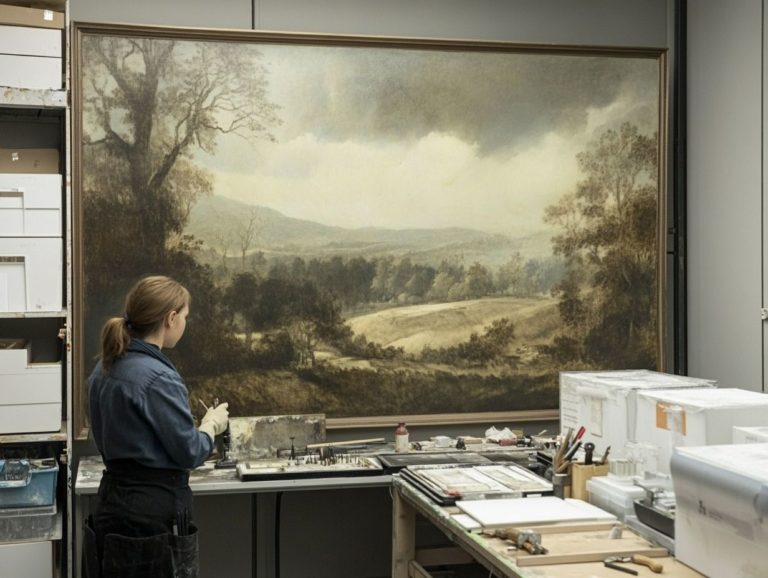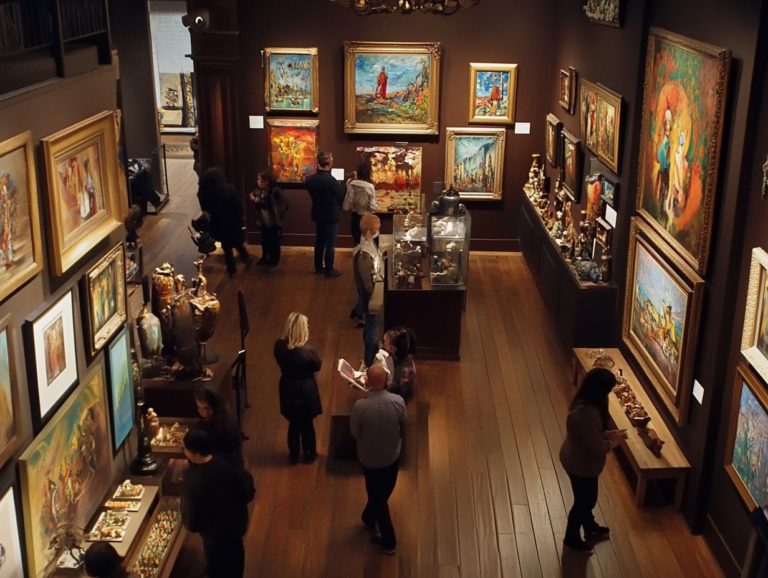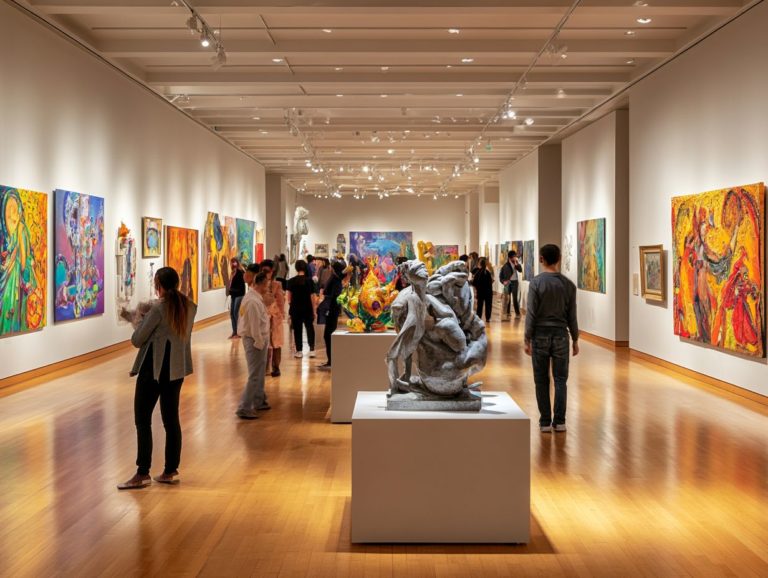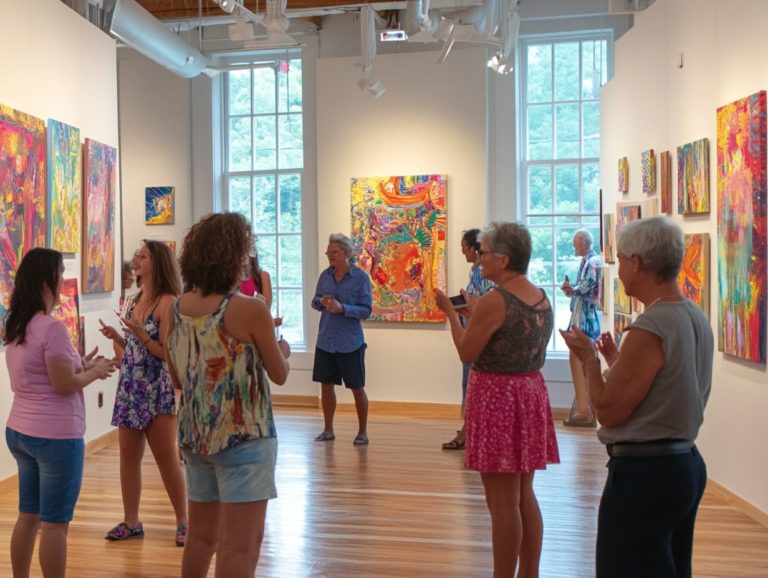5 Things Every Art Collector Should Know
Embarking on the journey of art collecting can be both exhilarating and daunting. With a vast landscape of styles, artists, and market trends, knowing where to begin may feel overwhelming.
This guide offers essential insights you should grasp, from understanding the art market and various art forms to setting a budget and researching artists.
Delve into the benefits and risks of owning art, empowering you to make informed decisions as you build your own collection. Whether you re a novice or seeking to refine your expertise, these tips will elevate your appreciation and investment in the captivating world of art.
Contents
- Key Takeaways:
- 1. Understand the Art Market
- 2. Educate Yourself on Different Types of Art
- 3. Know Your Budget and Stick to It
- 4. Research Artists and Their Work
- 5. Consider the Authenticity and Provenance of the Artwork
- How Can One Start Building an Art Collection?
- Frequently Asked Questions
- What are the five things every art collector should know?
- How can research benefit an art collector?
- Why is history of ownership important for art collectors?
- Why is art insurance necessary for art collectors?
- What are the different art mediums that collectors should know about?
- How important is a personal connection with the art for collectors?
Key Takeaways:
- Understand the art market and its trends to make informed decisions and avoid overpaying.
- Educate yourself on different types of art to expand your knowledge and appreciation for various styles and mediums.
- Set a budget and stick to it to avoid overspending and financial strain.
This knowledge helps you spot valuable pieces and navigate potential pitfalls.
This allows you to connect more deeply with the artworks you choose.
A realistic budget helps prioritize acquisitions without compromising your financial health.
1. Understand the Art Market
Understanding the art market can make or break your collection! It involves exploring various art styles, trends, and the intricate dynamics of the art world, including the roles of art dealers, galleries, and passionate collectors. For a deeper insight, check out the basics of collectibles and art.
Immerse yourself in key art styles like contemporary, modern, and abstract to discover what truly resonates with you.
Keeping an eye on trends, such as the rising interest in digital art and environmentally conscious pieces, can greatly influence your purchasing decisions.
Art fairs present invaluable opportunities for exposure. Connect directly with galleries and artists while deepening your understanding of market value and authenticity.
Engage with the art community at these events to enhance your knowledge and forge relationships that can inform your future investments.
2. Educate Yourself on Different Types of Art
Educating yourself about the diverse world of art exploring various styles, materials, and techniques is essential for nurturing a genuine passion and enhancing your appreciation.
Dive into the spectrum of artistic expression. From bold contemporary strokes to traditional works, grasp the rich narratives behind each creation.
As you explore these mediums, whether it’s paint, clay, or digital tools, you broaden your aesthetic horizons and foster a deeper connection with artists and their intentions.
Cultivating an understanding of art history enriches your appreciation and guides you to make informed choices that resonate with your tastes and philosophies.
By valuing the evolution of styles, you can curate spaces that reflect your unique journey through the captivating world of art.
3. Know Your Budget and Stick to It
Establishing a budget for art is essential for you as a collector. It guides your informed purchases while considering investment potential and equity building over time.
By setting a realistic budget, you can prioritize your desires and avoid impulsive decisions that could compromise your collection’s value.
This thoughtful approach helps you identify pieces that resonate with you personally and elevates your overall buying experience.
Although budget limitations may seem restrictive, they can be your greatest ally, fostering disciplined decision-making. In the long run, adhering to a well-defined budget enables you to discover hidden gems that align with your taste without overloading your finances, ultimately enriching your artistic journey.
4. Research Artists and Their Work
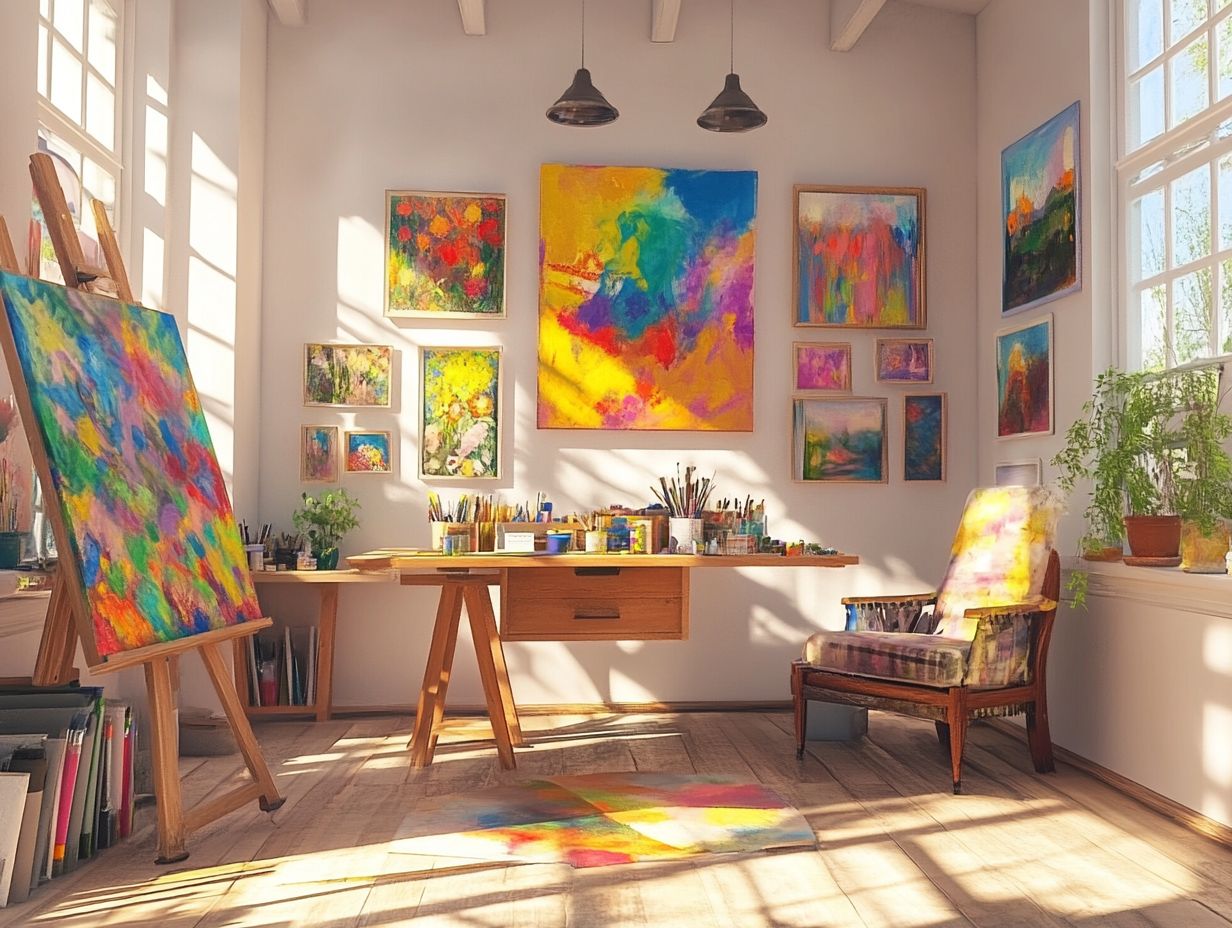
Researching artists and their work is an essential step in your art purchasing journey. This process allows you to meet artists and gain insight into their creative processes. You can also evaluate artwork through reputable dealers and galleries.
By immersing yourself in the art world through exhibitions, you can obtain firsthand insights into an artist’s vision and techniques. Attending these shows offers you the chance for meaningful conversations with artists, further illuminating their intentions and themes.
A thorough exploration of portfolios can unveil an artist’s evolution, highlighting how their style has matured over time. Engaging with knowledgeable art dealers provides invaluable guidance on the intricacies of valuation, empowering you to make informed decisions that enhance your collection and reflect the true worth of the artists in the market.
5. Consider the Authenticity and Provenance of the Artwork
When you invest in art, considering the authenticity and provenance of the artwork is paramount, as these aspects directly influence the art’s value and the integrity of your transactions.
Authenticity guarantees that a piece genuinely represents the work of the artist it claims to be from. Provenance means knowing the previous owners of the artwork and provides a documented history of its ownership and journey.
These elements serve as important parts in the valuation process, allowing you to navigate the complexities of the art market with confidence. Proper documentation weaves a transparent narrative that builds trust and alleviates concerns about forgery or misrepresentation.
As you nurture your collection, understanding how these factors intertwine empowers you to make well-informed decisions, ultimately enhancing your satisfaction and trust in your acquisitions.
How Can One Start Building an Art Collection?
Ready to dive into the world of art collection? Begin your exciting journey today!
Building your art collection requires thoughtful consideration and active engagement with the art market. Immerse yourself in the experience by attending art fairs and understanding potential purchases, while also exploring the basics of art authentication for collectors to ensure they align with your personal goals and interests as a collector.
Your journey begins with thorough research into various artistic styles, prominent artists, and current market trends. This groundwork allows you to make decisions that truly resonate with your individual taste.
Connecting with other collectors and galleries can offer valuable insights and open doors to unique opportunities. Networking at events gives you the chance to discuss and discover emerging artists, often uncovering hidden gems that might otherwise slip under your radar.
Keeping up with art news through reputable publications and online platforms ensures your collection remains both relevant and contemporary. Engaging with the community fosters meaningful relationships and enriches the overall collecting experience, transforming it from a simple acquisition process into a vibrant and fulfilling art adventure.
What Are the Benefits of Owning Art?
Owning art not only enriches your living space but also serves as a valuable investment, offering emotional satisfaction along with the potential for financial returns. This blend makes art collecting a rewarding adventure for passionate collectors!
The allure of unique pieces adorning your walls can effortlessly transform an ordinary environment into a sanctuary brimming with creativity and inspiration. For many, each artwork tells a story, inviting you into a profound connection with the artist’s vision.
You may find yourself drawn to art not just for its aesthetic value but also as a strategic move to strengthen your portfolio, with certain pieces appreciating significantly over time.
There are countless stories of enthusiasts who, after acquiring captivating works, developed a deeper appreciation for artistic expression. They frequently attend exhibitions and build connections with artists, further enriching their experience in the art world and making it all the more fulfilling.
What Are the Risks of Collecting Art?

Collecting art comes with several risks. The unpredictable nature of art values and the complexities of the market can affect how artworks are valued, impacting your investment.
Concerns about authenticity are significant; forgeries and misattributions can greatly lower a piece’s value. The art market is also susceptible to economic downturns. Therefore, it s essential to stay informed about market trends and shifts.
Conducting thorough research and consulting with experts will help you navigate these challenges. Staying updated on developments in the art world and understanding the legal frameworks around ownership can provide additional safeguards as you explore this intricate terrain.
How Can One Determine the Value of an Artwork?
Determining an artwork’s value involves a careful valuation process that requires more than a casual glance. You’ll need to research the artwork, the artist, and current market trends to make informed purchasing decisions.
Several key factors influence this evaluation:
- The artist’s reputation is vital. Recognized creators with established careers usually command higher prices due to their credibility.
- Market demand can fluctuate, affecting an artwork’s value based on its popularity and current trends.
- Provenance, or the documented history of a piece, can greatly enhance its worth. Collectors often prefer pieces with compelling backstories.
To navigate this complex landscape effectively, seek expert appraisals and utilize valuation tools like online price databases and auction results for a better understanding of these essential elements.
What Are the Different Ways to Purchase Art?
You have multiple options for purchasing art, from traditional methods like art galleries to contemporary approaches such as commissions and art fairs. Each option provides a unique experience for collectors.
For instance, art galleries showcase curated selections and offer access to knowledgeable staff who can assist in your decisions, but prices may be higher.
Studio sales give you a more personal experience, allowing you to meet artists and hear their stories, though they might not have the variety found in galleries.
Art fairs are vibrant venues with diverse works, although navigating through crowds can be overwhelming.
Art commissions allow you to collaborate directly with artists to create unique pieces that reflect your vision. Each method has its strengths and weaknesses, inviting you to explore what resonates best with your collecting style.
How Can One Protect Their Art Collection?
Protecting your art collection is crucial. This requires meticulous documentation, comprehensive insurance, and active engagement with the art community to safeguard your investments.
First, understand the importance of insurance for financial protection against theft, damage, or loss. Proper storage is also vital; store your artworks in the right conditions to keep them looking their best.
Maintain thorough documentation including provenance, appraisals, and photographs of each piece. This will streamline the process during claims or future sales.
Joining the art community can provide you with valuable support. Fellow collectors, galleries, and organizations often share resources and tips that enhance your ability to protect and appreciate your cherished collection.
Frequently Asked Questions
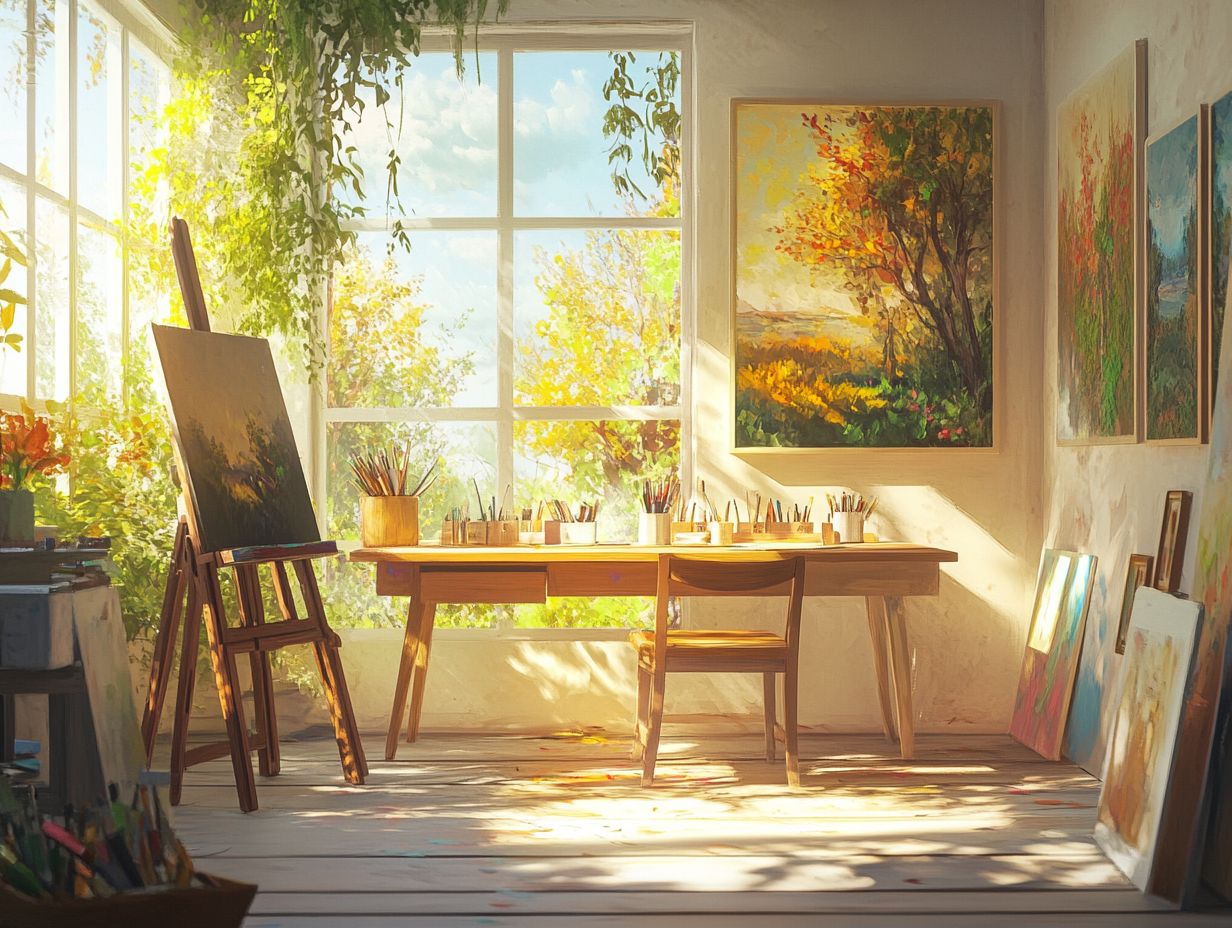
What are the five things every art collector should know?
Here are the five key points: research, history of ownership, art insurance, different art mediums, and a personal connection with the art.
How can research benefit an art collector?
Research helps collectors understand the background and significance of artworks. It also aids in verifying authenticity and value.
Why is history of ownership important for art collectors?
History of ownership is the documented record of a piece of art’s past. It verifies authenticity and provides insights into previous owners and exhibitions.
Why is art insurance necessary for art collectors?
Art insurance safeguards collectors from financial losses due to damage or theft. It’s vital to ensure adequate coverage for your collection.
What are the different art mediums that collectors should know about?
Collectors should understand various mediums like painting, sculpture, photography, printmaking, and mixed media. This knowledge helps grasp the techniques and processes behind the art, allowing them to avoid common pitfalls in the process, as outlined in art collecting mistakes to avoid.
How important is a personal connection with the art for collectors?
A personal connection enhances appreciation and understanding of the artwork. It also aids in making informed purchasing decisions.

